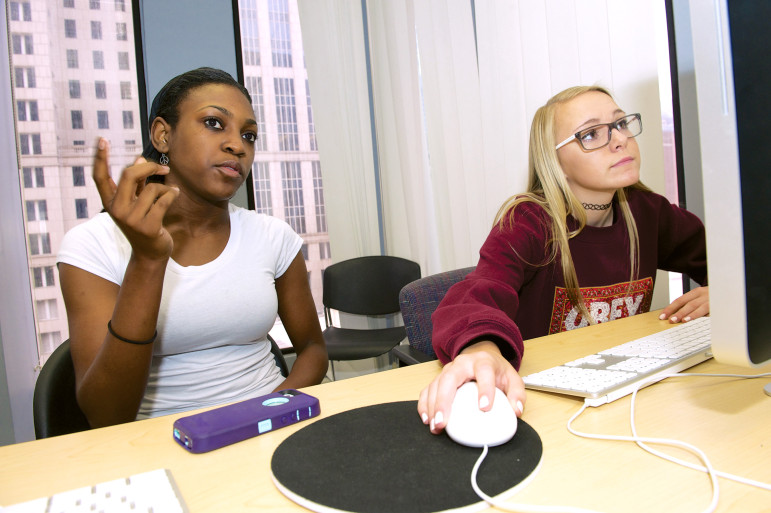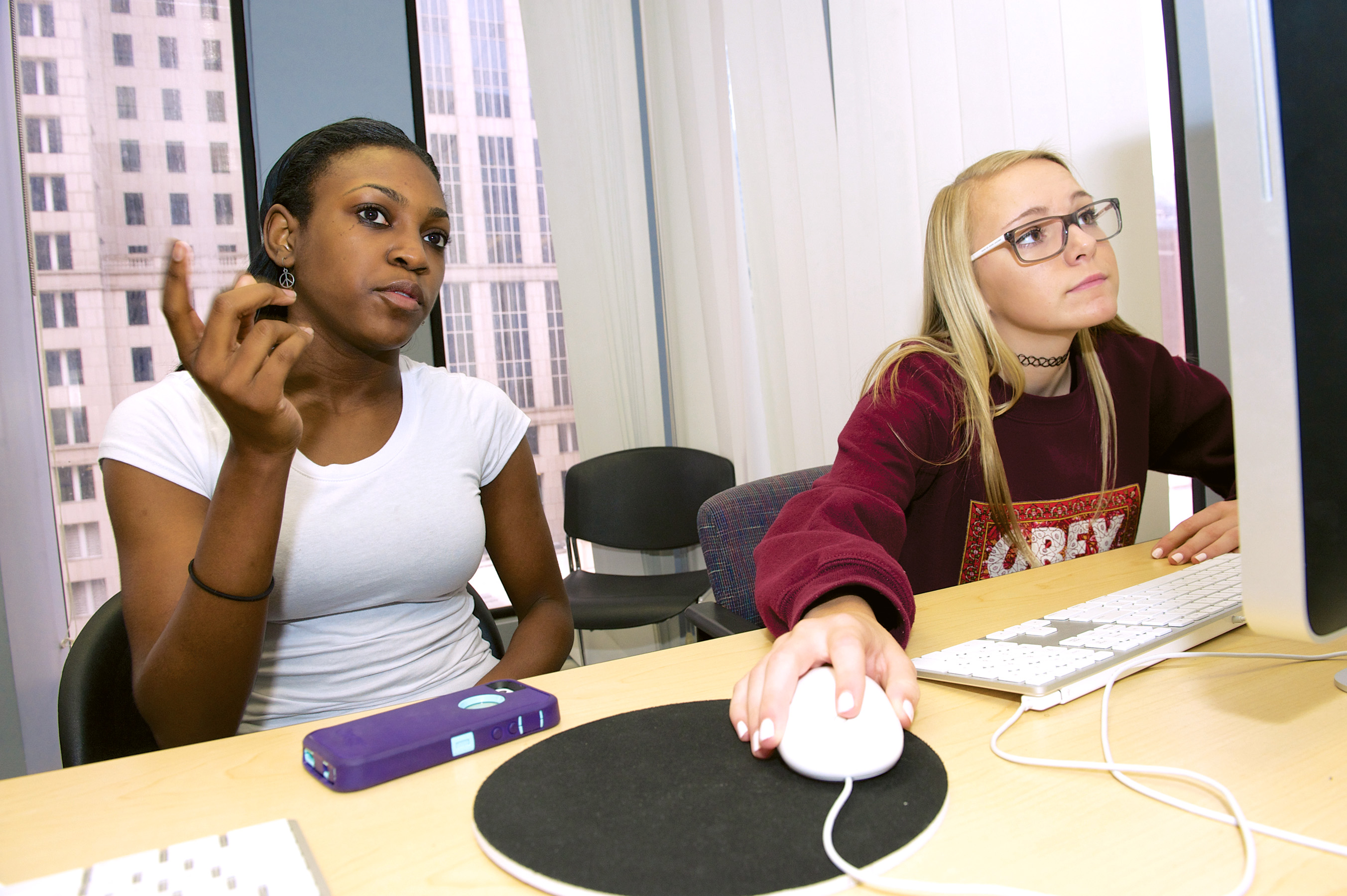
John Glenn
While some summer camps deliberately have kids unplug, many programs — like this one at VOX Media Cafe in Atlanta — use technologies as hands-on learning tools. With 75 percent of teens accessing the Internet with their cellphones, developing a technology policy for summer programs is a must.
Wherever kids go today, social media goes, too. In fact, in a recent study by Common Sense Media, 41 percent of teens called themselves “addicted” to their mobile devices.
Whether kids actually bring cellphones or other devices to an activity, they will be texting or communicating about it online. And, likely, the adults involved in the program also text and use social media, too, since 74 percent of all adults who use the Internet go to social networking sites, according to the Pew Research Center.
Given the propensity to use technologies at — and relating to — youth programs, what guidelines should organizations have? What issues should program leaders consider for maximizing its potential and minimizing harm?
Social media use
Ninety-five percent of U.S. teens are online, the Pew Research Internet Project reported in May 2013. And three-quarters of them access the Internet through their cellphones.
A 2012 survey by Common Sense Media reported that nine out of 10 teens had used social media and that the majority see it as a positive influence in their lives.
More than half of kids said they checked a social media site at least once per day, but 43 percent of the teens said they wanted to disconnect sometimes. More than one-third said they sometimes wished for a time when there was no Facebook.
Almost half reported that talking face-to-face is their preferred way to communicate, followed by texting.
And, of course, some have had negative experiences online.
One in six online teens say they have been contacted online by someone they did not know in a way that made them feel scared or uncomfortable, according to the Pew 2013 report “Teens, Social Media and Privacy.”
One-fourth of teens report being cyberbullied at some point in their lives, according to the Cyberbullying Research Center, founded by two criminologists who have been studying the subject since 2002. The Center defines cyberbullying as repeatedly picking on or ridiculing someone online or repeatedly posting something they don’t like.
Frederic Reamer, a professor in the School of Social Work at Rhode Island College, has written about ethics and social media. To his knowledge, there is no compilation of best practices for youth-serving organizations.
“It’s kind of a patchwork collection of guides that agencies have developed,” he said.
But developing a policy around social media is essential, he said.
Programs generally create two sets of guidelines, Reamer said: one for kids and another for adult staff and volunteers.
Policies for and about kids
In writing a policy, the goals include ensuring young people’s safety, protecting their privacy and keeping families informed. It’s also a chance to educate young people about communication via digital technology.
The guidelines for kids should explain the organization’s use of social media. What is appropriate for posting on Twitter or Instagram? Is friending, following or texting with adult staff allowed? Is email to be used for certain purposes but not others?
Kids in the Big Brothers Big Sisters mentoring program can communicate with their “big” through Facebook if they are at least 13 and their parent gives permission. Parents must sign a permission form before photos of their kids may be posted. The “big” must also sign a form agreeing to use privacy settings so that no information about the child can be viewed by the public.
Facebook is the only social media site permitted for direct communication between “bigs” and “littles.”
Some organizations actively involve kids in digital learning — teaching computer skills or video or radio production, for example. Darri Stephens, director of digital learning for Common Sense Media, suggests that programs might work collaboratively with parents and kids to draft a social media policy. If kids are using computers or other devices in the program, this approach can gain their buy-in, she said.
Other organizations, such as some summer camps, prohibit digital devices altogether.
In devising a policy, the first step is to consider the program’s mission, Christopher A. Thurber writes in Camping Magazine.
For example, Andy Pritikin sees his summer day camp as a time for digital detox. Like many other camps, Liberty Lake Day Camp, set on 64 acres in
New Jersey, does not allow its 1,000 summer participants to bring cellphones or other devices.
In a blog on the American Camp Association, Pritikin writes that electronic devices are everywhere and parents have trouble setting limits. Camp provides an opportunity to be in an unplugged environment.
Many programs seek to connect with kids by using social media. In that case, several questions are useful, according to the Youth Action and Policy Association, an Australian group for youth and youth workers. (For more resources, see below.)
- Why do we want to “connect” with young people online?
- What risks are there in this engagement that are similar to our offline practice?
- What risks are there in this engagement that are different from our offline practice?
- Given these risks, what are reasonable ways to manage these?
For staff and volunteers
Designate one or two people to handle a program or organization’s social media site/s so the tone and voice is consistent, recommends Joleen Ong, marketing and publications director of NTEN: The Nonprofit Technology Network. The audience doesn’t care who is posting, she said.
When posting photos of anyone under 18, it’s important to have parents’ permission, she said.
Youth organizations vary widely in the rules they set for staff and volunteers.
For example, only about half of youth mentoring organizations have a written policy on use of social media between mentors and mentees, according to research published in September in the Children and Youth Services Review. The article, “Mentoring in the digital age: Social media use in adult-youth relationships,” reported that 59 percent of mentoring programs allow mentors and mentees to friend each other on Facebook. The remainder prohibited or discouraged it.
Write a policy and make it clear at the outset, said Jean Rhodes, director of MENTOR/UMB Center for Evidence Based Mentoring and an author of the article. Don’t wait until issues arise, she said.
“If there are not clear expectations ahead of time, it’s a recipe for hurt,” she said.
She cited a situation when a young person disclosed something time-sensitive on Facebook, but the mentor wasn’t checking Facebook and didn’t respond. Setting expectations around social media at the beginning could have prevented the problem.
Whether the policy allows or prohibits friending on Facebook should be communicated at the start.
A big issue with social media is that it can blur the boundaries between adult staff and program participants. Staff and volunteers in youth-serving agencies need to be mindful of their public persona, Rhodes said.
“They need to be intentional and aware they are in that role,” she said.
Adults can put privacy settings on social media pages so that everything is not visible. They can also create a separate social media account, such as a professional Facebook page for use with kids.
Organizations can also set up their own social site within the organization. The Boys & Girls Club of the Midlands in Omaha, Neb., for example, used a chat room within the myclubmylife.com site.
To keep communication on social media channels safe and positive, it must be public, according to the Boy Scouts of America Social Media Guidelines.
Staff and volunteers do not communicate with youth one-on-one through email or messaging features provided through social media sites.
Communication on Facebook would be on the “wall,” for example. Email communication would be copied to one or more adults.
No phone numbers, addresses or personal email addresses should be seen publicly, the guidelines state.
The guidelines also call for consistent posting and monitoring on a troop’s social media page.
Rhodes sees great value in social media and digital communication among youth-serving organizations. It allows for easier, more timely communication between youth and their mentors and helps build relationships, she said.
It also allows kids to ask questions, raise issues and make disclosures when they are ready.
“Just because it’s digital doesn’t mean it’s any more or less dangerous” than other communication, she said.
“If you shut off those avenues of communication,” you may shut off a lot of valuable communication, she said.
Resources / for more information:
- Common Sense Media recently released a report (and infographic) reviewing research on the role of media and technology in kids’ and teens’ body image, attitudes and behaviors.
- The Nonprofit Times “10 Issues To Address In Your Nonprofit’s Social Media Policy” (July 2014).
- Social Work Today “Developing a Social Media Ethics Policy”
by Frederic Reamer (July 1, 2011). - TechSoup “Creating Social Media Policy” (Oct. 15, 2012)
Sample policies:
- Consideration for Use of Social Media by Clemson University Programs.
- University of Idaho 4-H Youth Development.
- Some faith-based organizations have given particular thought to youth social media policies, which can be found online.
- Archdiocese of Cincinnati offers guidelines and a sample policy for download.
- United Church of Canada posts their guidelines online.
- Chapel Hill United Methodist Church, Wichita, Kan., includes guidelines for photo usage, video chat, email and more.


























